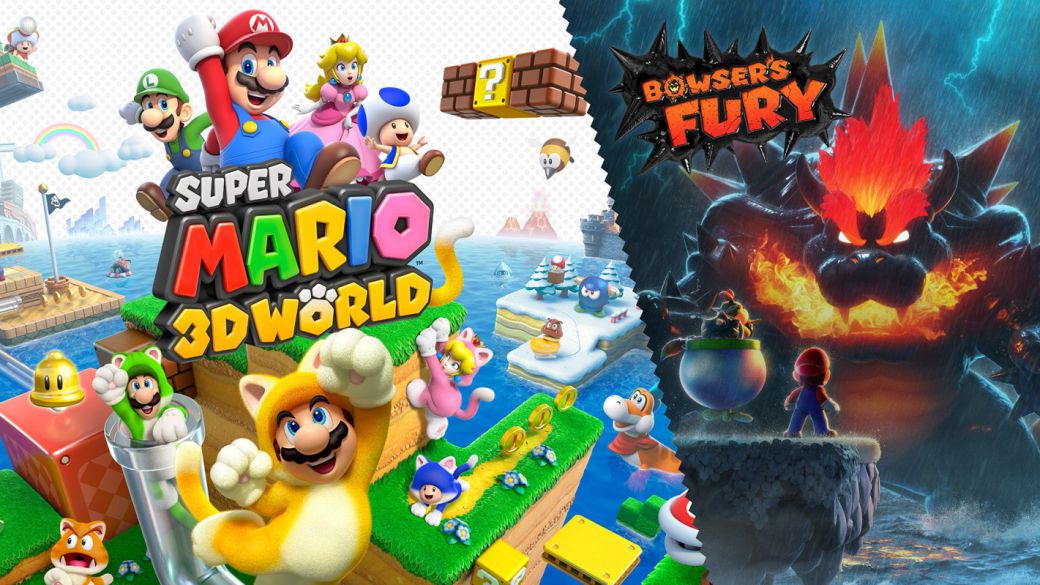
The Wii U platformer is reborn on Switch with online multiplayer, major control tweaks, and a brand-new expansion.
Saying this is not going to surprise anyone, but Super Mario is the best-selling video game series ever. Today it has more than 350 million copies sold, and it is a figure that does not include spin-offs such as Mario Kart or Mario Party. Only platform games. Open commenting something like this is not to congratulate the directors or investors of Nintendo, who are surely very happy with the results of their mascot, but to remember that a saga does not reach those numbers without gathering a series of factors. Longevity, accessibility, ability to reinvent yourself. Virtues that, however, sometimes have their small disadvantages, because expanding the number of proposals and fans also means ending up in situations where you cannot please everyone. And for example, the relatively widespread disappointment that followed the original announcement of Super Mario 3D World for Wii U.
At that E3, the console had just received a delivery of the New Super Mario Bros. series half a year earlier, so many expected from the new Mario a project of greater scale and creativity, which would pick up things where the marvelous Mario Galaxy had left them 2 or return to the more open worlds of Mario 64 and Sunshine. But what they saw instead was an extension of the 3D Land concept, a portable game designed to bridge the gap between the 3D platform and the audience more akin to side scrolling. Of course, putting it that way is telling half the story. Or rather, a quarter. Because 3D World used that formula to implement a four-player multiplayer that now, seven years later, not only revalues it next to a Mario Odyssey that has satisfied the need for the “great” Mario 3D, it also weighs less thanks to several fundamental adjustments to the control and the addition of an expansion, Bowser’s Fury, which adds several hours of single-player content.
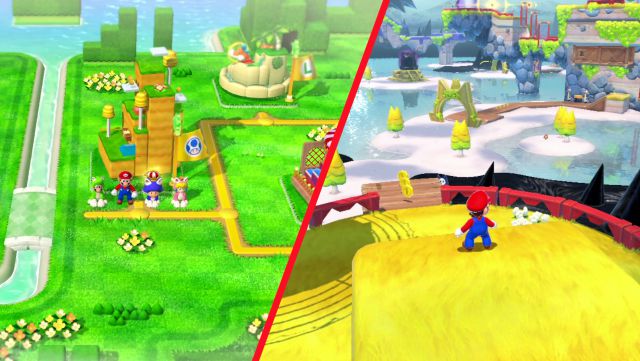
Cats and vertical platform
Although we have already expanded on this in the preview, for those who come from scratch it is worth remembering quickly that one of the most remarkable characteristics of the 3D Land / World period was the suppression of some fundamentals of the three-dimensional era inaugurated by Super Mario 64 as the analog acceleration or movement in 360 degrees, and also of techniques such as the triple jump or the forward throw, as well as a considerable reduction in the range of others such as the long jump. None of these changes was arbitrary, they all responded to precepts such as enabling the use of crosshairs, facilitating the maintenance of a specific direction in narrow places or balancing the multiplayer so that there was not a very large gap between players with different degrees of skill.
Having up to four characters running across the same screen also required new considerations about the skillful space needed to move without getting in the way of each other – resulting in levels much wider than 3D Land – and for the camera to allow the action to be followed even when each player focus their attention on different parts of the stage. With that need in mind, it is easy to understand why, despite other omissions, Nintendo did recover an absent spinning jump from Sunshine and, above all, why the central power-up was a catsuit that allows travel great vertical distances. through almost any surface. Although the ultimate goal is to reach a flag located — as a rule — at the far right end of each level, these constantly introduce elevations that prevent, or at least limit, running forward while ignoring the group.
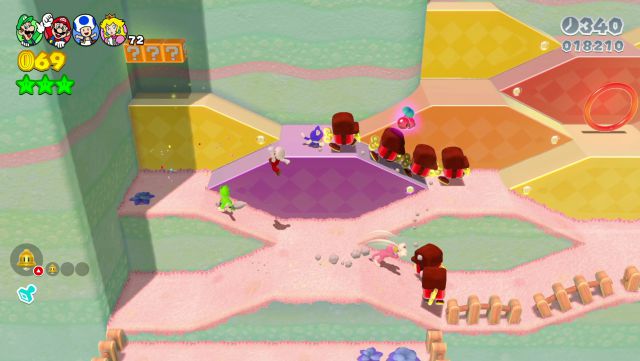
It’s not a foolproof design principle, and sometimes it’s outright ignored for the sake of variety – as in the Mario Kart-inspired phase that fills the floor with turbo panels – but it clearly or subtly conditions level construction. Even in cases where the basic route remains horizontal, the game constantly tempts us on the sides or at different heights with interrogation blocks that can include power-ups to give us a margin of advantage, entrances to bonus areas that drag everyone inside. the players to participate together in a quick challenge, and the three green stars that are hidden or placed in visible places difficult to access to reward both observation and platforming prowess.
Green stars and exploration
Green stars are one of those solutions so Nintendo oriented to fulfill several functions at once. Solo, they offer significant rewards for spending some time exploring instead of running to the finish flag, as a good handful of levels or even several points in the main development require adding a specific number to enter. It is a fairly light revision of the Super Mario 64 formula that allows developers to fill the levels with distractions (not all of them lead to stars, but the player does not know it, so participate to find out) and also encourages replayability in terms of worlds Advanced players start asking for more (the number required to access the final boss is not too high, but the requirements to unlock content continue to escalate after the credits).
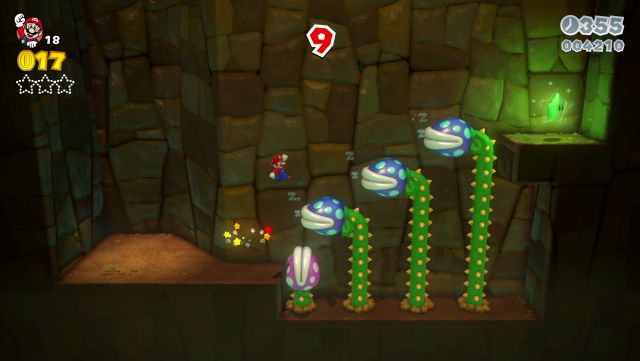
Continuing with the other functions, one of them applies more in the short term and with a view to multiplayer: since the winner of one level – and worthy of a crown at the beginning of the next – is not the first to reach the goal, if not the one with the highest score, the stars are one of the most precious goods because they are worth more points than picking up power-ups, defeating enemies or touching the flags. On the other hand, and ending with them, these stars are also in charge of drawing a difficulty curve parallel to the main one, higher because, although a certain number is necessary to progress, it does not include them all, so the study It can propose more demanding challenges without consequences for those who give up — unless we go for 100%, of course, in that case we have to make an effort.
Cherries and analog for the solo gamer
Another important consideration about the dichotomy between multiplayer 3D World and single player 3D World is that this way of conceptualizing the design also translated into both benefits and potential playable drawbacks. The need to collaborate to position oneself on switches that are only activated with two or more players, for example, was surely what gave rise to the cherries, a new power-up that clones the character that takes them in order to complete these tasks alone . This, far from being a simple “patch”, gives rise to some of the most fun and crazy situations in the game, since in groups it increases the chaos by multiplying the number of characters on the screen even more, but alone it also offers original challenges by requiring the player to coordinate their own clones to survive to the point where they can be used to get a star.
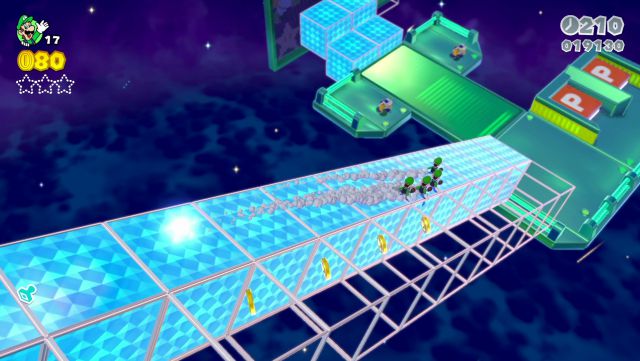
Although the greatest consequence of multiplayer is, of course, the introduction of several characters with differentiated handling that enrich the proposal even playing alone. Taking notes from Super Mario Bros. 2, Mario is the most balanced, Luigi jumps higher at the cost of having less traction on the ground, Peach can float a bit in the air at the cost of being slower than the rest and Toad has the higher top speed, although it also falls faster and requires more skill to master. Another subtle difference between them all is the time it takes to reach that top speed, since 3D World treats acceleration differently than any previous installment. And on Switch, in turn, differently than on Wii U.
As in the 2D installments, designed for controllers with digital crosshairs – also applicable to Wiimotes compatible with the original version of 3D World – in the Wii U edition, running required holding down a button at all times. Not doing so meant moving at an extremely slow speed and also seeing very limited jumping actions. Therefore, pressing the button was not an option, and said race then had to add a small turbo after several seconds -variables depending on the character- to increase something more a speed that still did not reach that of other deliveries. This three-rhythm system, like the orthogonal direction correction, served to simplify things and assist players less accustomed to the three-dimensional platforming, although as a result it produced secondary effects such as the involuntary holding of other characters because running, grab and use shared button objects.
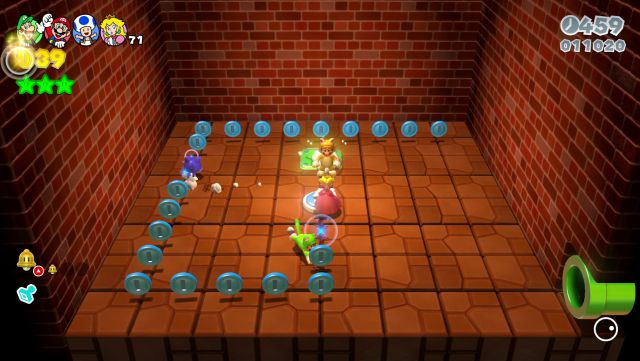
Luckily, while such a confluence of actions persists on Switch, the new version makes a key change that helps mitigate the initial problem: while using a button to run remains, the standard speed – simply shifting the analog – has increased. considerably, and with it also the range of jumps, resulting in a more agile handling like Mario 64 or Odyssey. It is something to which the replacement of the Wiimotes by the Joy-Con has surely contributed, which can also be used horizontally as a NES controller without losing the advantages of the sticks. In this way, the button sprint and the delayed turbo become extra tools that, like the long jump or the new forward launch (pressing the crouch and roll buttons at the same time during a running jump), they enrich the repertoire without devaluing other options.
Good on Wii U, better on Switch
It could be expressed in many ways, but it is the key idea. Super Mario 3D World on Switch does not have the novelty factor of Wii U – for those who have already played it on that console, of course – but it does have a more fluid control, portability (at 60 fps and without ups and downs in quality), upload of resolution in dock (from 720p to 1080p), a new photo mode (where we can use the stamps with drawings hidden in the levels and once dedicated to the Miiverse service), multiplayer implementation in the Captain Toad tests – puzzles in diorama code that evolved to get their own game – and online. The latter is a somewhat limited addition, yes, since it is limited to games between friends and can perform well or present jerks depending on the connection of the participants. We have experienced both types of games and, although it is not a game that requires the precision of Smash Bros., it is clear that this facet is not yet Nintendo’s strong suit.
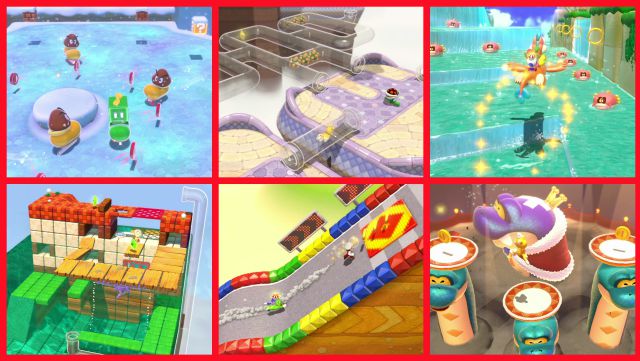
On the other hand, the design is, and 3D World serves to illustrate it: level, after level, after level, the game is a constant stream of ideas that does not stop until several hours have passed. The difficulty curve, very smooth at the beginning, has time to climb to some of the highest points in the entire series, and along the way it introduces mechanics and obstacles at a pace that no platform rivals. It is true that its enormous variety is achieved by sacrificing unifying themes such as the space opera of Mario Galaxy or the trip around the world of Odyssey. And also that the level of bosses and mini-bosses is somewhat below average at this point – another consequence of needing each element to work for four simultaneous players. But as a compilation album of best hits that also premieres some new ones and is aimed at both the public of decades ago and the new generations, its ability to curdle a harmonious whole that does not give a single lurch is commendable.
Bowser’s Fury: More Than a Lap of Honor
And as if the basic content were not enough (it is difficult to make precise estimates as some unlocks are proposed, but it is easy to exceed 15-20 hours), Nintendo has also created an unprecedented expansion to accompany it. Perhaps not too surprising after Pikmin 3 Deluxe and, above all, Xenoblade Definitive did the same upon arrival on Switch, but here the company has definitely gone a step further: although relatively brief (it has taken us almost three hours to reach credits and then two more to complete it 100%), Bowser’s Fury stands out and offers a differentiated experience, at times closer to adventurous deliveries such as Sunshine or Odyssey than to 3D World itself despite sharing a graphic engine and many of its playable concepts .
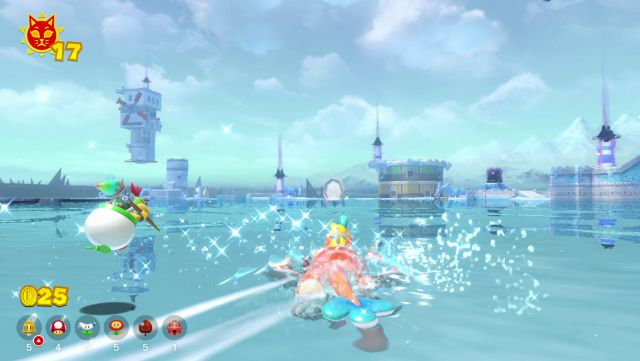
This is due to its independence (you can start directly, without touching the rest of the game) and, above all, its single-player approach. Although it supports asymmetric cooperative thanks to Bowsy – a rival temporarily turned into an ally that can attack enemies and deliver items scattered around the environment to Mario – exploration and platform are left in the control of a single person, allowing the player to rotate freely. camera and also move freely between challenges that are no longer compartmentalized on their own level, but are spread throughout a huge archipelago through which we sail on the back of the dinosaur Plessie.
Each individual component is inherited from 3D World, be it Plessie himself, power-ups like the cat suit or the boomerang flower (storable five at a time to retrieve them at any time), stage elements such as transparent pipes or directional platforms , common enemies and even some mini-bosses, all of them now also adorned with feline features. But they are pieces used to build a new mini-platforms, much more open not only in terms of the physical space that unfolds before us – which sometimes has small costs for performance – but also of the objectives that we can meet and the order in which we can fulfill them. Naturally, not everything is available at the beginning and we have to gradually unlock the areas by collecting suns and defeating Bowser, but its brevity serves to ensure that this expansion has the most flexible structure since Mario 64.

Controlled fury
Although, curiously, the installment most honored by the study seems Mario Sunshine, from which he recovers the aforementioned Bowsy, the idea of gradually cleaning an environment contaminated by black paint or calling the main collectibles suns (well, feline suns). Each area is also crowned by a lighthouse around which its tests take place, and although many are its own, appropriate to the specific design of the area in question (flying to the top of a fortress in the air, making your way into an invisible tower, slide on spikes using a skateboard, etc.), other tasks are recurrent and as soon as they consist of collecting a series of blue coins against the clock such as chasing an ink spectrum that takes the form of Luigi or look for a key to free a caged sun.
More concentrated than usual, but Bowser’s Fury is a purebred collectathon with dozens and dozens of suns to search for, some of them in the open sea (there is no shortage of speed tests for Plessie), others linked to secondary collections and others only obtainable with Bowser’s help. Because yes, the title is not chosen at random and every now and then Mario’s archenemy bursts into the middle of the map, bigger and more furious than ever. These appearances are frequent, but they do not last long, so it requires some planning to take advantage of them to get their attacks to destroy special blocks behind which several of the longed-for suns are hidden. Catching one of them also makes the nearest lighthouse light up and temporarily repel Bowser, restarting the exploration cycle in peace.
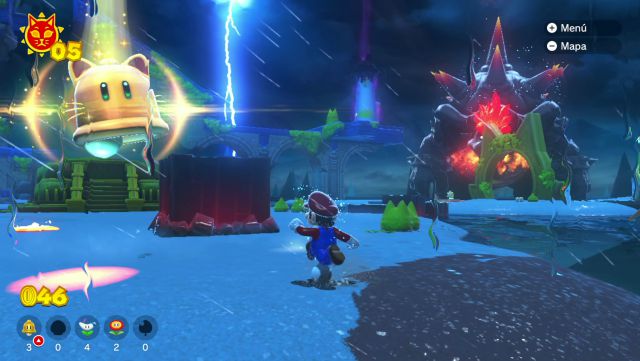
However, sooner or later direct conflict is inevitable, and one of the functions of the suns is precisely to unlock the giga-bells that give Mario a giant version of the cat suit to give Bowser what he deserves. They are quite simple combats, but spectacular thanks to the change in scale: the scenarios for which a few minutes before we were looking for suns seem like toys on the ground, and both Giga Mario and Giga Bowser move more slowly to reflect that they are now multi-ton creatures. As with the base game, Bowser’s Fury will not go down in history for its bosses, but as a curiosity it works and complements an expansion that shines in what needs to shine the most: the platform.
CONCLUSION
Super Mario 3D World is coming to the Switch surely later than many expected, but it does so in an effort to make up for lost time. It is an excellent adaptation of an excellent game, which first fits the original experience on the hybrid console without creating fissures, then revises and modernizes it at the controls level, and then on top of that, decides to add a high-quality expansion to make the relaunch an event. worthy of the saga and not a simple checkbox in the ports list. The online, also released, does leave us some doubts about how it will work according to what situations —or connections—, but at its best it is an experience that is difficult to replicate on other platforms, and both the base game and Bowser’s Fury make sure that all fans find something made for you.
THE BEST
- The amount of levels and concepts that it brings together. One of the most complete platforms ever created.
- The multiplayer, offline or online, offers crazy moments.
- Although the difficulty curve is somewhat smooth, it ends up climbing towards real challenges.
- The changes in speed and jumps from Wii U pay off for the better.
- Bowser’s Fury. Several hours of new content with touches of the best Mario 3D.
WORST
- Lag can cloud online gaming.
- Somewhat low level in bosses and mini bosses.
Excellent
A benchmark title of its kind, which stands out above its competitors and that you will enjoy from start to finish, probably several times. A game destined to become a classic over the years.
